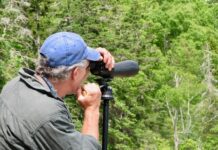 Oh dear! With the opening of Maine Moderns: Art in Seguinland, 1900–1940 at the Portland Museum of Art on June 4, I fear the rest of the world will be let in on one of Maine’s best kept secrets: The Phippsburg and Georgetown peninsulas.
Oh dear! With the opening of Maine Moderns: Art in Seguinland, 1900–1940 at the Portland Museum of Art on June 4, I fear the rest of the world will be let in on one of Maine’s best kept secrets: The Phippsburg and Georgetown peninsulas.
Historically known as Seguinland, these bony fingers reaching seaward from Bath and framing the Kennebec retain the essence of Maine: They’re relatively undeveloped, pocketed with lobster boat-filled coves, home to classic fishing villages, and despite being firmly in the rock-bound coast camp, have lovely sand beaches. No wonder that a small group of American modernists chose to summer here in the first half of the 20th century.
Exhibition who’s who
Moderns: Art in Seguinland, 1900–1940, on view through Sept. 11, 2011, will feature more than 65 paintings, sculptures, drawings, and photographs by such well known, Maine-related artists as Mardsen Hartley, Max Weber, Marguerite and William Zorach, Gaston Lachaise, and Gertrude Käsebier. The exhibition will examine the close personal and professional relationships of this group and distinctive landscape that bound them together.
Although much of their artistic activity was centered in New York, along with their mentor the photographer and art dealer Alfred Stieglitz, these artists all chose Maine as their summer home. It was here that they developed a camaraderie and sense of place that strongly influenced their work.
The exhibition begins with an examination of pictorial photographs by F. Holland Day, Clarence White, Gertrude Käsebier, and others taken around Day’s home in Georgetown and White’s summer art school at the neighboring Seguinland Hotel. Maine Moderns will take a look at the work of modernist painters Max Weber and John Marin, who both showed their Maine images in Stieglitz’s New York galleries.
Why Seguinland?
In the early 1920s, sculptor, Gaston Lachaise, bought a summer home and studio in Georgetown and welcomed painter Marsden Hartley back to his native state, when Hartley returned to work here in in 1928. Other frequent visitors to the Lachaise house during this period included photographer, Paul Strand, and painters Marguerite and William Zorach, who had settled at the other end of Robinhood Cove not far from the Lachaise house. Among the latter group, it was the Zorachs whose work most frequently depicted this region.
Seguinland provided a unique artistic experience in Maine and was distinct from the better known art colonies at Ogunquit and Monhegan Island that were also active during this period. In those places, larger numbers of both professional and amateur artists congregated for lessons and exhibitions, intermingling with a tourist community. But the two coastal areas south of Bath, Georgetown and Phippsburg, remained more isolated during the first half of the 20th century. The few artists there were a select group of individuals drawn by the distinctive coastline and their shared interests in modernism. This is the first occasion to fully examine their relationships to one another and the role of Maine in the broader development of modernism.
See the exhibition, then take it home with you
A 160-page fully illustrated catalog will be issued for the exhibition. It will features essays by Susan Danly, curator of photography at the Portland Museum of Art, and Elizabeth Bischof, assistant professor of history at the University of Southern Maine, along with entries penned by Verna Curtis, curator of photography, Library of Congress; Gail Scott, independent Hartley scholar; and Virginia Budny, author of the Lachaise catalogue raisonné. The catalog will be available in June and sell for $39.95 in the museum store.
(Image credit: Mardsen Hartley [United States 1877–1943], Fox Island, Georgetown, Maine. Addison Gallery of American Art, Phillips Academy, Andover, MA.)













